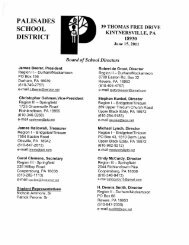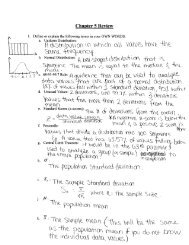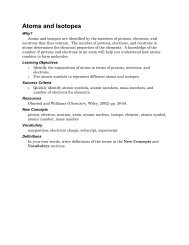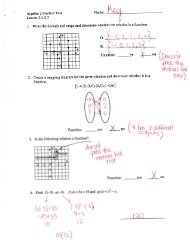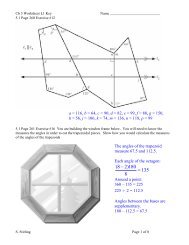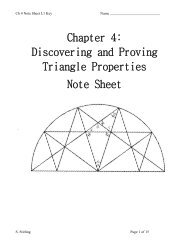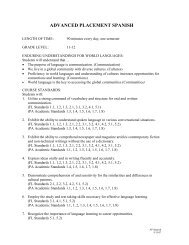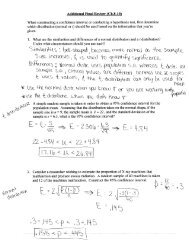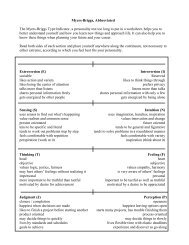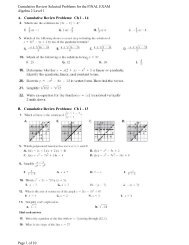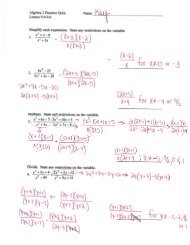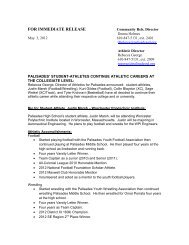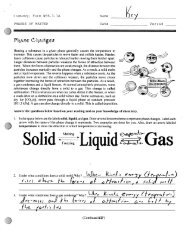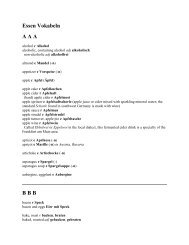ii Iii nil
ii Iii nil
ii Iii nil
Create successful ePaper yourself
Turn your PDF publications into a flip-book with our unique Google optimized e-Paper software.
_______________<br />
____________<br />
Cr[: Form WS11.3.2A<br />
Name<br />
ORGANIC CHEMISTRY Date<br />
Period<br />
Wa<strong>ii</strong>it Har11$<br />
A substituted hydrocarbon is a hydrocarbon with an<br />
element other than hydrogen attached somewhere along<br />
the hydrocarbon chain. It is named in a similar fashion to<br />
a hydrocarbon. This can be illustrated with alcohols as an<br />
example. The compounds pictured to the lower left are<br />
alcohols. They look like alkanes<br />
H with —OH at one end where a<br />
I hydrogen would have been. The<br />
H—C—j--OH<br />
—OH is called a functional group.<br />
H The rest of the molecule is called a<br />
H H residue (R). The general formula<br />
for alcohols is R—OH. CH3OH, the<br />
H—C—COH first alcohol pictured to the left is<br />
formed by substituting an —OH<br />
H H<br />
group for hydrogen on methane<br />
H H H<br />
I I I<br />
(CH<br />
H—C—C—C—--OH<br />
R—-OH<br />
CH3CH2CH2OH is 1-propanol.<br />
4). As a result, it is called 1-<br />
methanol. The suffix ol shows that<br />
it is an alcohol. The root met/ian<br />
comes from methane. The number<br />
1 shows the location of the —OH.<br />
The next alcohol in the series,<br />
CH3CHOH, formed from ethane,<br />
is called 1-ethanol.<br />
The alcohols and several other classes of substituted<br />
hydrocarbons are found in Table R. The root is determined<br />
by counting the number of carbons in the chain. For<br />
halides, the substitution is identified with a prefix. For the<br />
remaining substitutions, a suffix is used. (See Table R.) As<br />
with all hydrocarbons, the number and location of groups<br />
needs to be identified.<br />
<strong>ii</strong> I<strong>ii</strong><br />
H—C—C—C—H<br />
I ,2,2-trifluoropropane<br />
3<br />
1.CH3CH,CHOHCH<br />
<strong>nil</strong><br />
H—C—C—C—C—H<br />
2-butanone<br />
Table R<br />
Organic Functional Groups<br />
CIas of Funcdonal General<br />
Compound Group Formula Example<br />
—F(fluoro-) R—X<br />
halide — Cl (chioro-) (X represents CH3CHCICII<br />
(hakicarbon) — Br (bromo-) any halogen) 2-eblorepropane<br />
-I (iodo-)<br />
alcohol —OH R011<br />
ether —0— R—O—R’<br />
3<br />
2OH<br />
CH3CH,,UI<br />
1-propanol<br />
2CH3<br />
CH3OCI1<br />
methyl ethyl ether<br />
0<br />
0 0<br />
II<br />
aldehyde It II CH3CH2C—H<br />
—C—H R—C—H<br />
propanal<br />
0 0 0<br />
ketone II II<br />
—C— R—C—R’ CH3CCHCH<br />
2-pentanone<br />
2CH3<br />
0 0 0<br />
organic acid It II<br />
II<br />
—C—OH fl—C—OH<br />
propanoic acid<br />
CH.CH<br />
2C—OH<br />
0 0<br />
0<br />
II<br />
ester II II CNCHCOCH<br />
—c—o— R—c—o—ir<br />
methyl propanoate<br />
amine<br />
— N—<br />
ir<br />
CH3CYJ<br />
2<br />
2CHaNH<br />
B—N—fl” 1-propanamine<br />
0<br />
0 OR’ It<br />
amide It I II I<br />
—C—NH fl—C—NH<br />
CH3CHaCNH<br />
popanamide<br />
2<br />
Name the following compounds using the rules for naming hydrocarbons and by referring to the reading and Table<br />
R above.<br />
2. H——!!—J—H<br />
H<br />
H<br />
Continue ir
________________<br />
eitrf: Form WS 11 . 3 . 2A<br />
Naming Substituted Hydrocarbons<br />
ORGANIC CHEMISTRY Page 2<br />
3. H___J—!!—OH<br />
H<br />
2CH3<br />
4.CH3CH2CH2OCH<br />
5. CHOCH<br />
6. H_L_i4__O—_J,_H<br />
H H H<br />
0<br />
II<br />
7 CH3CH2CHCH<br />
8.CH3CH2CH2CHOHCH<br />
2CH2CH2CH3<br />
9. CH3CHO<br />
2CH,CH<br />
10.CH3CH2COOCH<br />
2CH3<br />
11. H—i—J——OH<br />
12. CC1<br />
4<br />
H<br />
H<br />
13. CF,CH,<br />
0<br />
14. HC—O—CH<br />
3<br />
2CH3<br />
15.CH3CH2OCH<br />
2CH2CH2OH<br />
16.CH3CH2CH,CH<br />
17.CH3CH,CHOHCH2CH2CH3<br />
2CH2CH2CHO<br />
18.CH3CH2CH2CH,CH<br />
2CH2CH2CH2CH3<br />
19.CH3CH,CHBrCH<br />
3<br />
2CH,CFI<br />
20.CH3CHNH<br />
© Evan P. Silberstein, 2003
to describe common reactions of organic compounds<br />
5:rajjc aci@i<br />
__<br />
triple bonds)<br />
* Definition -<br />
of hydrogen to an alkene or an<br />
alkyne (or other carbon compounds with double or<br />
\ / II<br />
/ \<br />
CC + Br<br />
2 — H-C-C-H<br />
H H HH<br />
* Addition<br />
* halogenation -<br />
* Definition = Adding two or more atoms to carbon at a<br />
* Characteristics<br />
* Examples<br />
* take place more easily than substitutions<br />
* unsaturated bonds are more reactive than saturated<br />
* results in the formation of a single product<br />
bonds and alkynes are more reactive than alkenes<br />
point of unsaturation<br />
ane + bromine —, monobromoethane + hydrogen bromide<br />
eth<br />
H—C——C—H + Br<br />
* example: halogen substitution<br />
* with insufficient oxygen —‘ CO and water<br />
* example: C2H8 + 502 3CC, + 4H20<br />
—‘ * example: 2C3H, + 702 6CC + 8H20<br />
- * Substitution<br />
with sufficient oxygen —‘ CO2 and water<br />
* Combustion -<br />
burning<br />
replacement<br />
Ill<br />
I II<br />
H H H H<br />
occurs<br />
addition<br />
* Hydrogenation<br />
H H BrBr<br />
at room temperature<br />
2 H—C—C—H + HBr<br />
of hydrogen in saturated<br />
Some reactions of hydrocarbons<br />
hydrocarbons<br />
ebrf: Form Lsll.4A Name<br />
ethylene monomer polyethylene<br />
n<br />
(<br />
* Esterification -<br />
glucose — ethanol + carbon dioxide<br />
C6H12 06 ““ > 2C2H50H + 2C0<br />
* Fermentation -<br />
2<br />
* fruit flavorings and aromas<br />
* lipids are formed by esterification of glycerol by<br />
* Polymerization -<br />
* importance:<br />
* General formula: RCOOR<br />
* Formation: ROH + RCOOH - RCOOR + H2O<br />
* produces organic salts called soaps<br />
* forms glycerol as a byproduct<br />
* Saponification -<br />
fatty acids<br />
breakdown of organic molecules<br />
during anaerobic respiration<br />
enzymatic<br />
formation<br />
hydrolysis<br />
formation<br />
H H II H H H H H<br />
II II II II<br />
HH)<br />
* the process can be repeated to form long chain<br />
* examples: vinyl plastics - polyethylene, polystyrene<br />
(--)n<br />
H\_/H<br />
* condensation polymers must have at least two<br />
monomer monomer<br />
j1 )i 11<br />
OH—C—C—OH OH—C—C—OH —- OH—C—C—O—C—C—OH<br />
* Polymer - large molecule formed from many smaller,<br />
* Condensation - joining monomers by dehydration<br />
* Addition polymerization -<br />
involves<br />
I I<br />
and triple bonds of unsaturated hydrocarbons<br />
* examples: silicones, polyesters, polyamides,<br />
of fats by bases<br />
repeating units of smaller ones<br />
repeating units or monomers<br />
synthesis<br />
polymers<br />
phenolic plastics, and nylons<br />
of esters<br />
of large molecules from<br />
functional groups<br />
opening up double<br />
dimer<br />
ORGANIC CHEMISTRY Date Period
zrf: Form Nll.4A<br />
ORGANIC REACTIONS<br />
ORGANIC<br />
CHEMISTRY<br />
Page 2<br />
Answer the questions below by circling the number of the correct response<br />
1. One of the products produced by the reaction betweenCH3COOH<br />
and CH3OH is<br />
(1)HOH<br />
(3)HCOOH<br />
(2)H2S0 4 (4)CH3CH2OH<br />
2. A fermentation reaction and a sponification reaction are similar in<br />
that they both can produce<br />
(1) an ester (3) an acid<br />
(2) an alcohol (4) a soap<br />
3. The product of a reaction between a hydrocarbon and chlorine<br />
was 1,2-dichloropropane. The hydrocarbon must have been<br />
(1)C 5H10 (3)C<br />
(2)C2H4<br />
(4)C4H8<br />
3H6<br />
4. The product of a reaction between a hydrocarbon and chlorine<br />
was 1 ,2-dichloropropane. The hydrocarbon must have been<br />
(1)C 5H10 (3)C<br />
(2)C2H4<br />
(4)C4H8<br />
3H6<br />
5. The reactionC3H6 + H2 —C3H8 is an example of<br />
(1) substitution (3) polymerization<br />
(2) addition (4) esterification<br />
6. The reactionC2H4 + H2 —‘C2H6 is an example of<br />
(1) addition (3) saponification<br />
(2) substitution (4) esterification<br />
7. A reaction between an acid and an alcohol produces an ester and<br />
(1) carbon dioxide (3) glycerol<br />
(2) water (4) ethanol<br />
06<br />
8. The fermentation ofC6H12 will produce carbon dioxide and<br />
(1) a polymer (3) an ester<br />
(2) a soap (4) an alcohol<br />
9. The reaction:C4H8 + Cl 2 —C4H8CI is an example of<br />
(1) substitution (3) polymerization<br />
(2) addition (4) fermentation<br />
2<br />
10. A reaction betweenCH3COOH and an alcohol produced water<br />
and an esterCH3COOCH Which alcohol was used in the<br />
reaction?<br />
(1) CH3OH(3)C3H7OH<br />
(2)C2H5OH(4)C4H9OH<br />
3.<br />
11. The hydrolysis of fat by a base is called<br />
(1) saponification (3) polymerization<br />
(2) esteriflcation (4) neutralization<br />
12. Which is the product of the reaction between ethene and chlorine?<br />
(1) H———Cl (3)<br />
H H H H<br />
H<br />
(2) H—I—-Cl<br />
H<br />
H<br />
(4) cl—c—cl<br />
13. Which equation represents an esterification reaction?<br />
(1)C6H12 — 2C2H50H + CO2<br />
(2)C ÷H2—’C<br />
(3)C3H8 + Cl 2 —C3H7CI + HCI<br />
(4) HCOOH + CH3OH — HCOOCH + HOH<br />
06<br />
5H10 5H12<br />
3<br />
14. In a condensation polymerization, a product always formed is<br />
(1) water (3) oxygen<br />
(2) hydrogen (4) carbon dioxide<br />
15. The organic reaction,<br />
HCOOH +CH3CH2CH2CH2OH —, HCOOCH + HOH,<br />
is an example of<br />
(1) fermentation (3) polymerization<br />
(2) esterification (4) saponification<br />
H<br />
2CH2CH2CH3<br />
16. Which compound will undergo a substitution reaction with chlorine?<br />
(1) CH4 (3)C3H6<br />
(2)C2H4<br />
(4)C4H8<br />
17. The reaction represented by the equation nC2H4 —‘ (-C2H4-)n is<br />
called<br />
(1) saponification (3) esterification<br />
(2) fermentation (4) polymerization<br />
18. Which organic reaction involves the bonding of monomers by a<br />
dehydration process?<br />
(1) substitution (3) addition polymerization<br />
(2) oxidation (4) condensation polymerization<br />
19. The reaction CH3OH + HCOOH —. HCOOCH + H20 is an<br />
example of<br />
(1) hydrogenation (3) esterification<br />
(2) polymerization (4) addition<br />
3<br />
20. The reactionC4H10 + 2—’C4H9Br + HBr is an example of<br />
(1) substitution (3) fermentation<br />
(2) addition (4) polymerization<br />
© Evan P. Silberstein, 2003
16C0<br />
________________________________<br />
car: Form WS11.4.1A<br />
Name<br />
ORGANIC CHEMISTRY Date Period<br />
Ua?.,i,i atic 1act3ir<br />
Hydrocarbons participate in a variety of chemical reactions. Some are described below.<br />
Combustion. Fossil fuels such as the gasoline used in automobiles or the propane used in gas barbecues are<br />
hydrocarbons. When they burn, they release carbon dioxide and water. (CJH 8 + 502 —p 3C0 2 +4H20). Of course,<br />
when there is insufficient oxygen, as in an automobile engine, the carbon does not oxidize completely, and carbon<br />
monoxide and water forms. (2C 8H18 +<br />
—<br />
1702 + 18H 20). That is why automobile exhaust contains carbon<br />
monoxide.<br />
H H<br />
Substitution. Saturated hydrocarbons have all their bonding<br />
sites filled with hydrogen. The only way to attach any other<br />
elements to the carbon chain of a saturated hydrocarbon is to I I<br />
H<br />
replace the hydrogen. The replacement of the hydrogen with<br />
another element is called substitution. The diagram to the right<br />
shows halogen substitution.<br />
Addition. When there is a point of unsaturation, it is possible to<br />
add elements to the hydrocarbon chain at that point without<br />
removing any hydrogens. This is called addition. Unsaturated<br />
bonds are more reactive than saturated bonds and alkynes are even<br />
more reactive than alkenes, so additon of halogens occurs at room<br />
temperature. Addition of hydrogen to an alkene or an alkyne (or<br />
other carbon compounds with double or triple bonds) is called<br />
hydrogenation. It is the processed used to make margarine from vegetable_oil.<br />
Fermentation. Beverage alcohol is formed by yeast. It forms as a<br />
result of the enzymatic breakdown of organic molecules during<br />
anaerobic respiration. It is called fermentation.<br />
Esterification. Esterification is the formation of esters (RCOOR).<br />
Esters form from a reaction between an organic acid and an alcohol.<br />
The alcohol and acid join by dehydration synthesis. The reaction looks<br />
similar to an acid base neutralization. Esters are responsible for fn<strong>ii</strong>t<br />
flavorings and aromas of flowers.<br />
They are synthesized as artificial<br />
flavors. Lipids (fats and oils) are<br />
formed by esterification of glycerol<br />
(1,2,3-propanetriol) by fatty acids<br />
(long chain organic acids)<br />
H—C— OH H —C—(CH,)a---—CH<br />
Saponification. Saponification is the<br />
H—C— OH H —C—(CH 2)——cH<br />
hydrolysis of fats by bases. When<br />
sodium hydroxide reacts with a fat it<br />
produces organic salts called soaps<br />
plus glycerol as a byproduct. The<br />
reaction looks much like the reverse<br />
of the formation of the fat, except<br />
that the fatty acid becomes a sodium<br />
H—C— OH<br />
H<br />
H —C—(CH,)——CH<br />
salt [NaCH3(CH 2)C00].<br />
H<br />
ethane + bromine —1-bromoethane + hydrogen bromide<br />
ethene + bromine —* 1,2 -dibromoethane<br />
glucose<br />
r H 0 H 0<br />
2C2H50H + 2CO<br />
ethanol + carbon dioxide<br />
Alcohol + Acid — Ester + Water<br />
2)——CH<br />
3<br />
3 H—c——--O—c—(CH<br />
0 0<br />
2)——CH<br />
3 H—C——--O—C—(CH<br />
0 0<br />
2<br />
3 +3H,O<br />
2)----CH<br />
3<br />
3 H—,———O—C—(CH<br />
1ycero1 + 3 Fatty acids Lipid + 3H20<br />
Continue<br />
Formation of fat by esterification<br />
H
large molecules from repeating units of smaller<br />
Polymerization. Polymerization is the formation of<br />
ORGANIC CHEMISTRY Page 2<br />
4<br />
__________________________________________<br />
_____________________<br />
© Evan P. Silberstein, 2003<br />
is this?<br />
tetrafluoroethene. Then show the result of the reaction using structural formulas. What type ofpolymerization<br />
6. Teflon, a common non-stick cooking surface, is a polymer of tetrafluoroethene. Draw a structural formula of<br />
5. What is the process ofjoining many small molecules into larger molecules is called?<br />
4. How is soap made?<br />
will addition occur?<br />
2. A hydrocarbon reacts with fluorine. Under which conditions will substitution occur, and under which conditions<br />
1. What forms from the complete combustion of a hydrocarbon?<br />
Answer the questions below based on the reading above and on your knowledge of chemistry.<br />
many smaller, repeating units or monomers. Polymerization by condensation<br />
—<br />
Polymers can form by condensation<br />
monomers by dehydration synthesis. Condensation<br />
polymers must have at least two functional groups. The<br />
process can be repeated to form long chain polymers.<br />
Examples include silicones, polyesters, polyamides,<br />
hydrocarbons. Examples<br />
phenolic plastics, and nylons. Addition polymerization<br />
involves opening up double and triple bonds ofunsaturated<br />
include vinyl plastics -<br />
polyethylene and polystyrene. Addition polymedzation<br />
3. What is butylpentanoate? How does it form? ______________________________________________<br />
c=cziHn<br />
ones. A polymer is a large molecule formed from ________________________________________________<br />
r[: Form WS 11 -<br />
. 1A Understanding Organic Reactions<br />
joining



